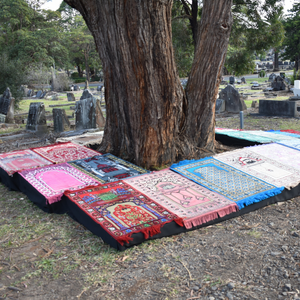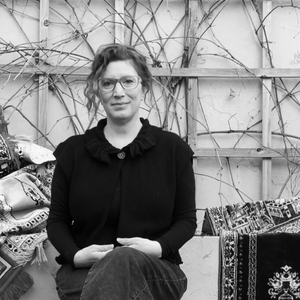 WINNER - The WEST Journal Award for Western Sydney Artists
WINNER - The WEST Journal Award for Western Sydney Artists
Songs for Sitti: prayers for my grandmother (2022)
Family prayer rugs, chiffon scarfs, camping stools and soundscape

I never had to bury anyone in the soil or the seas of this land. I come from a small migrant family. I never said goodbye to Sitti, my grandmother, and her passing always seems like a dream. This work honours her legacy amongst the trees on the beauty of Dharug land. I carry with me her red prayer rug, her white chiffon scarf, and her voice. I use prayer rugs offered with blessings from family and friends. The soundscape is layered with my voice singing from Sitti’s repertoire, old tape recordings of her voice with family, as well as the call to prayer I recorded while visiting my hometown in 2019. I invite visitors to sit, listen, meditate, and remember those who we never said goodbye to.
Listen to Maissa's Songs for Sitti:
About the Artist

Maissa Alameddine grew up in Lebanon and now lives on Gamaragal Country in Sydney. She is a multidisciplinary artist and vocalist, who explores the idea of migration as a chronic injury and uses her voice as a provocation and a response. Maissa has been part of the contemporary Arab Australian arts community for over twenty years, performing with Arabic music ensembles, Western orchestras, and art organisations. She is a founding member of Western Sydney-based Arab Theatre Studio, has been an artist in residence at Urban Theatre Projects, and performed with LIVE DREAMS at Carriageworks and at the Art Gallery of NSW.
Transcription
My work is an honouring to my grandmother's legacy and what she has left me with. My memory of her is very vivid. I feel like I live with her and her legacy in my day to day and therefore in my art practice. My grandmother is very musical, and so was her, her mother and grandmother, and so I have recently embraced the inheritance that was given to me or left for me, which is my voice.
I grew up in and around my grandmother's house, where songs and prayers collide, and really there was no clear marking or separation between music and prayers and we often prayed together and sang together in one sitting. My Grandmother told us stories, she sang us songs, she prayed for us and with us. A lot of the music I know and I sing recently is thanks to her, my aunties and the extended family they come from this long ago memory. I have created a sound piece made out of sound bites from old tapes that she used to send to us with friends who were coming to Australia. They were voice letters and more the tapes were of her recording stories for us. There were news about what's happening, her health, everyone else's the country what's happening, and there were also recordings of prayers and songs, a lot of songs. My grandmother started each tape with how much she missed my mother, how much she missed each and one of us, and how she wished we were all together in the gathering that was about to happen.
The work is also made out of what started as my grandmother's prayer rug, the red prayer rug that I clearly remember her using. She only prayed on that one. And so then I wanted to involve my sisters and my family and my friends and asked them if they would like to connect with me on this work. And everyone, Um, was really excited and really wanted and understood the meaning of what I'm trying to do. Um. So they gave me their prayer rugs with intention and blessings for Sitti's memory. Being situated in the cemetery I had a vision that this work is for reflection. I Had a vision that the prayer rugs needed to be on the ground and that my voice needed to somehow collide with my grandmother's voice. I felt like I needed to be in there with her singing or praying. I had a big urge to, like I said, in my sisters and my mother to contribute, and then my close friends. It felt like it needed to be something communal, some togetherness for city. Not necessarily a funeral, I would never think to replace that, but a way to come together to remember her.
I had many conversations about this with friends and with my family and it felt like actually, people who have this history of migration, people in the diaspora, feel this deeply where they've lost someone and never grieved. So the experience was shared between us on that level. So I went from there and collecting the prayer rugs and wanting to do this work started making more sense. I never had to bury anyone in the soil or seas of this land. I come from a small migrant family. I never said goodbye to city. Her passing feels like a dream. Not long ago I visited Rookwood to pay respect to a friend's mother. I cried for her. I think I cried then for my grandmother, and perhaps only then I realized that she's actually gone. Rookwood HIDDEN drove me to realize this work that has been dormant. I have made work about my connection with my ancestor's and memory, but this opportunity feels special. I feel it brings me, my family and my friends together for a special moment in time. I'd like the viewer or the visitor to sit, reflect and listen to perhaps meditate and remember a loved one who they never said goodbye to.